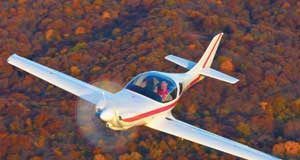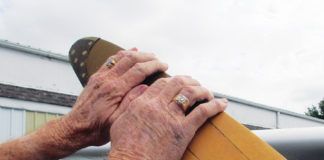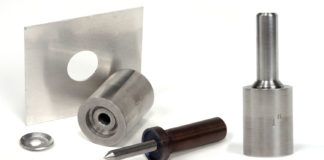
This is a familiar story to anyone who has been around homebuilding for long. In the earliest days, the toughnecks who would dare to create aircraft with their own hands were, by necessity, scroungers. In fact, many of our most beloved designs started with bits and pieces of certified, series-production aircraft. Cub wings, for example, spawned many offshoot designs, and you can see the logic. Nothing wrong with a Cub that a better fuselage wont cure, and nothing wrong with the airfoil that a bit of clipping cant fix. In many ways, experimentation was more a part of the industry than it is today.

Once upon a time, builders could go to Superiors Coppell, Texas, U.S. headquarters and help build their engines.
Scrounging, which we admit is a polarizing term, also extended to the powerplants. From early auto-engine conversions to borrowing the engine that had come out of a damaged production airplane, the early days of homebuilding called for more than a little shopping savvy and horse-trading skill.
Even as recently as the late 1970s and early 1980s, very few homebuilders could afford (or would agree to pay for) factory-new engines. It just wasn’t done. Instead, the process began by finding a good core engine. The rapid growth of general aviation in this period-in the late 1970s, Cessnas production of the 172 numbered 40 a week-meant that in stark contrast to the previous period, aircraft were far more disposable, putting many more cores into the free market. That good core might then end up at your local A&Ps shop, a close-by engine specialist, or your garage. In time, a completed engine would emerge. Ah…good times.
Eventually, good cores became harder to find, particularly for the parallel-valve Lycoming O-360. Other forces were at work. In the production tumbledown of the early 1980s, the those in GA responded by keeping aircraft longer, overhauling and repairing the existing fleet rather than opting for outright upgrade or replacement. As part of this push came the first non-original-manufacturer parts for engines.
Old Names, New Games
We can credit Engine Components, Inc., and Superior Air Parts for kicking this off. From humble beginnings sourcing odd bits and pieces for engine overhaulers-often just as an alternative to the original equipment manufacturer (OEM) who might have trouble keeping pace with supply, or be charging more than the market was willing to bear for certain components-these companies eventually came to produce enough parts to make whole engines.
A key component of this shift was the push for aftermarket cylinder assemblies in the 1980s and 1990s. At the time, the OEMs were charging quite a lot for replacement cylinder assemblies, all the while the GA fleet was seeing the durability of these components failing to keep up the value part of the equation. Into this opening jumped ECI and Superior, both of which developed replacement items under a Parts Manufacturing Authority that allowed the cylinders to be used on certified aircraft.

Engine Components, Inc. has the ability to machine complex parts-like, say, a crankshaft-at its San Antonio, Texas, manufacturing facility.
While both companies improved on the certified product in many ways-after starting by reverse engineering the certified part-the market shook out with ECI providing alternative cylinder-finish options mated to conventional (though improved) cast heads, while Superior developed an investment-cast cylinder design called the Millennium. At first, Superior seemed to focus on the large-bore Continentals, while ECI worked the odds by paying rapt attention to the four- and six-cylinder Lycoming designs. Eventually, of course, both companies met in the middle, providing an amazingly vast array of components for virtually all of the popular engines in the fleet.
Homebuilders to the Fore
Meanwhile, on the Experimental side of the ledger, we saw the growth of overhaul facilities that supported or even directly focused on the homebuilder, sometimes for the average Joe, but often with a performance or racing application in mind. At first, these shops began working with overhauled (or overhaul-able) cores and modifying them to suit, opening up and cleaning the inlet and exhaust port, modifying squish bands, specifying taller pistons for more compression ratio-all the usual hot-rodder tricks to get our half-a-horse-per-cubic-inch engines a bit more lively. (Some learned about too lively from excessive compression or porting that cut a little too close to the bone. Power hungry owners learned to live with a short fuse.)
Further down this timeline, we find those hot-rod shops working directly with the aftermarket suppliers to create new options for builders. ECI introduced the Titan Kit Engine program in 1998. The idea was to have engine shops around the country receive all the components they needed to build an engine from one source, a source that could (and did) undercut the factory in price. That would give the shop an opportunity to make money on the parts and the labor-what a concept!

Mattitucks TMX line of clone engines was at one time made up of parts from ECI, Superior and Lycoming. With Superior out of the picture, Mattitucks options are limited, though the company continues to turn out signature engines for homebuilders.
Superior took another route. With the XP series introduction in 2001, the company offered intriguing options. Builders could take the engine as a completed assembly right from Superior, go to Coppell, Texas, and help build their own engines or receive a box full of parts for a true DIY adventure.
Between them, ECI and Superior helped keep mom-and-pop shops afloat but also supplied a substantial portion of the raw materials to larger concerns such as Long Island-based Mattituck. In time, these clone engines, built all over the world, pressured market prices down and helped make the choice for a lot of builders: For many years, the difference between a solidly overhauled engine and a foundry-fresh item from the aftermarket was so close that the only reasonable thing to do was buy new. Whats more, the clone market pushed innovation such as new bearing configurations, reduced-weight components, improved induction systems and a push for better accessories such as ignitions, starters and charging systems.
End of an Era
Lycoming entered the kit-engine arena in 2006, supplying shops with a full array of new components, and that further expanded the possibilities. Then Superiors dinghy was pulled under by the sinking of parent company Thielert, and ECI has faced its own series of economic and production difficulties. The upshot is that in the middle of 2009, the clone engine marketplace is contracting at the same time Lycoming continues its push with the Thunderbolt line of Experimental engines. Will economic factors drive us back to an OEM-only industry, where scrounging for cores becomes a builders pastime once more? Time will tell.




